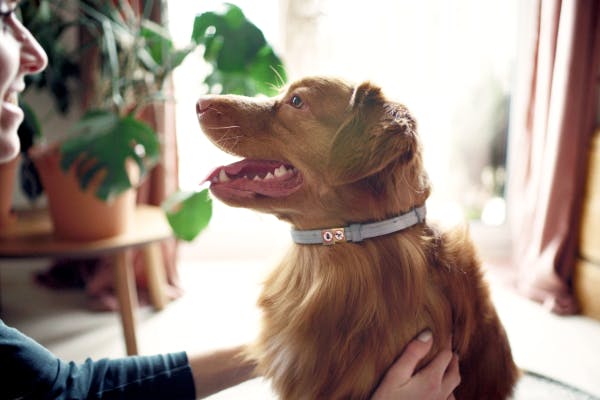learn about orthopedic dog beds
How Orthopedic Dog Beds Help Dogs with Arthritis
Orthopedic dog beds, made of memory foam or other firm materials, provide better support for dogs with arthritis by reducing pressure on joints and promoting proper alignment. This helps alleviate pain and discomfort, making it easier for dogs to stand up and move around.

Arthritis is a common condition in dogs that affects their joints, causing pain and discomfort. Orthopedic dog beds are an effective tool in managing arthritis symptoms, as they offer better support than regular beds. These beds are made of memory foam or other firm materials, which help reduce pressure on a dog's joints and promote proper alignment, ultimately providing relief and improving mobility.
Understanding Arthritis in Dogs
Arthritis is a condition that affects the joints and can cause pain and discomfort in dogs. It is often seen in older dogs, but it can also develop in younger dogs with abnormal bone growth. Some breeds, like Yorkshire terriers and Chihuahuas, are more likely to have joint problems that can lead to arthritis.
Dogs with arthritis may have trouble getting up and moving around, especially in the morning or after a long walk. They might limp or be less active than before. It could also be hard for them to maintain the right posture when going to the bathroom.
An orthopedic dog bed is a helpful tool for dogs with arthritis or other joint issues. Many vets suggest these beds because they are made of memory foam or other firm materials that offer better support than regular beds with cotton stuffing.
Orthopedic dog beds reduce pressure on a dog's joints when they lie down and make it easier for them to stand up afterward. A softer bed might actually make arthritis pain worse because it can cause joint misalignment when the heaviest part of the dog sinks into the bed.
Causes of Arthritis in Dogs
Many factors can lead to arthritis in dogs. Some main causes are age, abnormal bone growth, genetics, and breed-related problems. Arthritis is often seen in older and larger dogs but can affect any age, size, or breed of dog. Younger dogs with unusual bone growth might get arthritis earlier.
Some breeds like Yorkshire terriers and Chihuahuas are more likely to have joint problems like luxating patellas (knee caps that slide out of place). This constant sliding can cause an accumulation of arthritis leading to significant pain over time. In bigger breeds like Great Danes, Mastiffs, and German Shepherds, hip dysplasia is a common cause of arthritis. Since hip dysplasia is a genetic problem, having breeding adults checked by a vet before breeding can help lower the risk of passing the condition to their puppies.
Arthritis can also be caused by the immune system attacking joints, resulting in inflammation and pain. This type of arthritis is called autoimmune or immune-mediated arthritis. Early diagnosis and treatment are essential for managing this condition and ensuring the dog's comfort.
best orthopedic dog beds
- our rating95 out of 100
- our rating95 out of 100
- our rating93 out of 100
Symptoms of Arthritis in Dogs
Dogs with arthritis may display various symptoms, indicating they need further examination and care. Common signs of arthritis include difficulty getting up and moving – especially after resting or in the morning – limping, reduced activity levels, and struggling to maintain proper posture while going to the bathroom.
Other less obvious symptoms may still indicate arthritis or joint pain; these include increased irritability, changes in appetite, reluctance to jump or climb stairs, stiffness around joints, or weakened muscles near affected areas.
It's important to remember that these symptoms could also signify other health problems. Therefore it's crucial to consult a veterinarian if there are any changes in a dog's behavior or physical abilities. Early diagnosis and treatment can make a significant difference in managing arthritis-related discomforts for dogs living happier lives.
What Makes a Bed Orthopedic?
Orthopedic dog beds provide extra support and comfort for a dog's joints and muscles. They are popular because they can improve the quality of life for dogs, especially those with health problems like hip dysplasia and arthritis. These beds utilize technology and high-density memory foam to alleviate pressure on a dog's joints and muscles, offering them a cozy place to rest.
Memory foam is a crucial component of an orthopedic bed. It is ideal for these beds because it conforms to the dog's body, distributing their weight evenly and relieving pressure on their joints. This foam offers both support and comfort, ensuring that the dog's spine and joints are well-supported while also being soft.
Some orthopedic dog beds feature additional layers of cushioning materials like egg-crate foam or gel layers. These extra layers can enhance the bed's supportiveness and help regulate the dog's body temperature, ensuring they remain comfortable in various weather conditions.
The design of orthopedic dog beds is also essential. Many of these beds have raised edges or shapes that provide additional support for a dog's neck and spine. These designs can be beneficial for dogs with joint problems or those that require extra support while sleeping.
The quality of an orthopedic dog bed is also important. High-quality beds will have durable materials like heavy-duty fabric and robust stitching that can withstand daily use. The bed should also have a removable, machine-washable cover for easy cleaning.
Benefits of Orthopedic Dog Beds for Arthritic Dogs
One significant benefit of orthopedic dog beds is that they provide excellent support and cushioning for a dog's joints and muscles. This helps distribute their weight evenly, reducing stiffness and pain in sensitive joints and muscles, and improving blood circulation. As a result, arthritic dogs can experience less pain and more comfort when resting.
Another advantage of orthopedic dog beds is that they can prevent further joint damage in arthritic dogs. The supportive materials in these beds, like memory foam, help relieve pressure on sensitive areas like hips, elbows, and shoulders. This can reduce the impact of arthritis on the joints and potentially slow its progression.
Orthopedic dog beds also help arthritic dogs sleep better. The memory foam in these beds conforms to a dog's body, creating a comfortable sleeping space that promotes deeper sleep. This is crucial for arthritic dogs because getting adequate rest helps them manage their condition and maintain overall health.
In addition to physical benefits, orthopedic dog beds can also improve an arthritic dog's mental well-being. Having a comfortable and supportive bed helps dogs feel secure and relaxed, reducing stress and anxiety. This contributes to better overall health for arthritic dogs.
Memory Foam vs. Other Materials in Dog Beds
Memory foam is popular for dog beds, but pet owners have other options as well. To choose the best bed for your dog, it's essential to understand how memory foam differs from other materials used in dog beds.
Memory foam is made from polyurethane foam that reacts to pressure and temperature changes by conforming to your pet's body, providing even weight distribution and alleviating pressure on their joints or muscles.
However, memory foam might not be the best choice for every pet or situation. Some pets may prefer a firmer surface or require more support than memory foam provides. For example, larger pets could benefit from a bed using higher-density foams.
High-density polyurethane foam offers more firmness than memory foam and provide extra support for larger pets or those suffering from specific joint issues. High-density polyurethane foam is also more durable than memory foam, making it an excellent choice for active pets or those that tend to chew their beds.
Egg-crate foam is another material option for dog beds. This type of foam has a unique surface that offers both support and cushioning for your pet. Egg-crate can help alleviate pressure points in dogs with joint problems while also being more affordable than memory foam.
Gel-infused foams are another alternative to memory foam, offering unique benefits for dogs. This material contains gel particles that help regulate temperature, keeping your pet cooler during hot weather. Gel-infused foams can be an excellent choice for pets who tend to overheat when sleeping.
In addition to these materials, many dog beds use polyester fillings as cushions. These options provide a soft, comfortable surface but may not offer the same level of support as other materials like memory or high-density foams. For healthy dogs without joint issues, a bed with polyester filling can be comfortable and cost-effective.
When choosing the right dog bed material, consider factors such as their size, weight, health issues, or preferences. Memory foam is popular because it conforms to your pet's body, providing even weight distribution. However, other options like high-density polyurethane, egg-crate, and gel-infused foams might be better suited depending on your pet's needs and preferences.
How to Choose the Right Orthopedic Dog Bed
Finding the perfect orthopedic dog bed involves considering various factors that meet your dog's needs and preferences. Orthopedic dog beds come in many shapes and sizes, so selecting the right one can greatly impact your pet's comfort and health.
Start by observing your dog's sleeping habits. Notice whether your dog likes to sleep curled up, stretched out, or leaning against something. This information will help you choose the best bed style – a bolster bed for cuddling dogs or a mattress-style bed for those who like to stretch out.
Consider your dog's size and weight. A suitable orthopedic bed should be large enough for your pet and provide ample support for their joints. Ensure the bed you select can handle your dog's weight without losing its shape over time.
The materials used in an orthopedic dog bed are crucial for providing proper support and comfort. Memory foam is a popular option because it conforms to a dog's body, relieving pressure on their joints. However, other choices like high-density foam or gel-infused foam might be better suited for some needs – such as gel-infused foam helping keep dogs cool if they get too hot while sleeping.
When choosing an orthopedic dog bed, also think about its durability. Opt for beds made from sturdy materials that can withstand frequent use. If your dog tends to chew or scratch at their bedding, look for beds that can resist this behavior.
Cleaning is another essential factor when selecting an orthopedic dog bed. Dogs may bring dirt, mud, and allergens onto their beds; therefore it is beneficial to find one with a removable cover that you can machine wash easily—keeping your pet's sleeping area clean and healthy.
Additional Ways to Help a Dog with Arthritis
Providing a comfortable and supportive orthopedic dog bed is vital for dogs with arthritis, but there are other ways to alleviate their pain and improve their lives. Here are more suggestions for pet owners:
Maintain a healthy weight: Ensuring dogs maintain an appropriate weight can reduce pressure on joints and alleviate arthritis pain. Overweight dogs might require a specialized diet or low-calorie treats to shed excess pounds. Regular exercise and monitoring food intake are also crucial for maintaining healthy weight.
Exercise regularly: Consistent low-impact exercise like walking or swimming can promote healthy joint mobility and maintain muscle strength in your dog. Gradually increase the intensity of the exercise according to your dog's ability, without overexerting them. Consult your vet for advice on suitable exercises.
Provide joint supplements: Joint supplements such as glucosamine and chondroitin can improve joint health and reduce arthritis pain in dogs. Always consult your vet before introducing new supplements into your dog's diet.
Physical therapy: Physical therapy can benefit arthritic dogs by improving mobility and alleviating pain—trained canine rehab therapists design tailored programs that may include stretching exercises, range of motion exercises, or massages.
Use anti-inflammatory medications: Non-steroidal anti-inflammatory drugs (NSAIDs) help reduce arthritis pain by minimizing inflammation in joints—these medications should be used under veterinary supervision who will determine the correct dosage based on individual needs while monitoring potential side effects.
Acupuncture: Acupuncture has been shown to significantly decrease arthritis-related discomfort—this treatment involves inserting thin needles at specific points on the body promoting healing while reducing pain levels; consult with trained veterinary acupuncturists for more information about this option
Heat or cold therapy application : Applying heat or cold therapies onto affected joints can help alleviate pain and inflammation. Use warm towels or heating pads for heat therapy, and cold packs for cold therapy, wrapping them in a towel to avoid causing discomfort; apply these short durations (no more than 15 minutes).
Create supportive environments: In addition to an orthopedic dog bed, ensure your dog's living space accommodates their needs—this might entail installing non-slip flooring, using ramps or stairs for easier access to furniture or vehicles, and positioning food/water dishes at a comfortable height.
Incorporating these additional measures into your dog's routine can improve overall quality of life while reducing arthritis-related pain—always consult with your vet before starting new treatments or administering medications to ensure they're appropriate for your pet's unique requirements.








